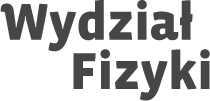- Dla kandydatów
- Dla studentów
- Informacje dla studentów I roku
- Informacje ogólne
- Informator o studiach
- Organizacja roku
- Zarządzenia Prodziekana ds. studenckich
- Kolokwia i egzaminy
- Prace i egzaminy dyplomowe
- Materiały dydaktyczne
- Pracownie
- Pracownia Projektów Studenckich
- Zespołowe projekty studenckie
- Oprogramowanie
- Konta i hasła w sieci studenckiej
- Studia doktoranckie
- Studia podyplomowe
- Samorząd, koła, kluby, chór
- Stypendia i sprawy socjalne
- Oferty pracy
- Dla pracowników
- Dla gości
- Badania
- Rada Naukowa Dyscypliny Nauki Fizyczne
- Kierunki badań
- Priorytetowy Obszar Badawczy II IDUB
- Realizowane projekty
- Sekcja ds. Obsługi Badań
- Seminaria i konwersatoria
- Konwersatorium im.J.Pniewskiego i L.Infelda
- Algebry operatorów i ich zastosowania w fizyce
- Środowiskowe Seminarium Fizyki Atmosfery
- Seminarium Zakładu Biofizyki
- Seminarium z fizyki biologicznej i bioinformatyki
- Seminarium Fizyki Ciała Stałego
- Multimedialne seminarium z ekono- i socjofizyki
- Exact Results in Quantum Theory
- Środowiskowe Seminarium Fotoniczne
- Seminarium Fotoniki
- Seminarium Zakładu Fotoniki
- Seminarium Gamma
- Seminarium "High Energy, Cosmology and Astro-particle physics (HECA)"
- Środowiskowe Seminarium z Informacji i Technologii Kwantowych
- Seminarium Fizyki Jądra Atomowego
- Seminarium fizyki litosfery i planetologii
- Seminarium Fizyki Materii Skondensowanej
- Seminarium "Modeling of Complex Systems"
- Seminarium nauk o widzeniu
- Seminarium "Nieliniowość i Geometria"
- Seminarium Optyczne
- Soft Matter and Complex Systems Seminar
- String Theory Journal Club
- Seminarium Koła Struktur Matematycznych Fizyki
- Seminarium "Teoria cząstek elementarnych i kosmologia"
- Seminarium KMMF "Teoria Dwoistości"
- Seminarium Teorii Względności i Grawitacji
- Seminarium "The Trans-Carpathian Seminar on Geometry & Physics"
- Seminarium Fizyki Wielkich Energii
- Konferencje
- Publikacje
- Research Highlights
- Optyka na Uniwersytecie Warszawskim
- Wydział
- Misja i strategia
- Władze Wydziału
- Zarządzenia Dziekana
- Zarządzenia Prodziekana ds. studenckich
- Struktura organizacyjna
- Historia Wydziału
- 90 lat Wydziału Fizyki
- 100 lat Wydziału Fizyki
- Fizykoteka – Wirtualne Muzeum Wydziału Fizyki UW
- Dziekanat
- Rada Wydziału
- Jakość kształcenia
- Stopnie i tytuły naukowe
- Nagrody Wydziału Fizyki
- Biblioteka
- Ośrodek Komputerowy
- Pracownicy i doktoranci
- Zamówienia publiczne
- Rezerwacja i wynajem sal
- Oferty pracy
- Osoby
- Zapraszamy
- Media
Seminarium Optyczne
sala 0.06, ul. Pasteura 5
Joanna Olesiak-Bańska (Politechnika Wrocławska)
Probing chiral one- and two-photon properties in noble metal nanoclusters
Noble metal nanoclusters (NCs) are ultra-small nanomaterials exhibiting optical properties intermediate to those of discrete molecules and bigger nanoparticles [1]. They possess exceptional linear and nonlinear optical characteristics, including tunable photoluminescence (UV-NIR), large Stokes shifts (>0.5 eV), high photostability, and significant two-photon absorption [2]. Importantly, many NCs display chirality, arising from chiral surface ligands, helical core motifs, or inherent kernel asymmetry [3]. These attributes make NCs excellent models for structure-property relationship studies and versatile tools in catalysis, bioimaging, and sensing.This work investigates the linear and nonlinear optical properties of NCs with diverse chirality origins. We synthesized and characterized NCs stabilized by: 1) chiral ligands within primary or secondary ligand shells (captopril, glutathione, arginin, single stranded DNA), and 2) achiral ligands where chirality was induced by the arrangement of staple motifs. To quantitatively assess chiral nonlinear optical properties, specifically two-photon circular dichroism (2PCD), we developed and employed two distinct methodologies: z-scan-based two-photon absorption measurements and fluorescence-detected two-photon excited luminescence measurements utilizing circularly polarized light [4, 5]. Our findings reveal that the 2PCD of these NCs is approximately 300 times stronger than their one-photon anisotropy factor. Furthermore, we successfully demonstrated the facile detection of both 2PCD and three-photon circular dichroism (3PCD) in chiral gold NCs [6]. This research provides critical insights into the interplay between chirality and nonlinear optical phenomena in NCs, opening new avenues for their application in advanced photonics and chiroptical technologies.References[1] I. Chakraborty et al., Chem. Rev. 2017, 117, 8208.[2] J. Olesiak-Banska et al., Chem. Soc. Rev. 2019, 48, 4087.[3] I. Dolamic, S. Knoppe, A. Dass et al. Nat. Commun. 2012, 3, 798.[4] J. Olesiak-Banska et al., RSC Adv., 2016, 6. 98748.[5] A. Pniakowska et al. Nanoscale 2023; 15, 8597-8602.[6] P. Obstarczyk et al. J. Am. Chem. Soc. 2024, 146, 51, 35011–35015.







